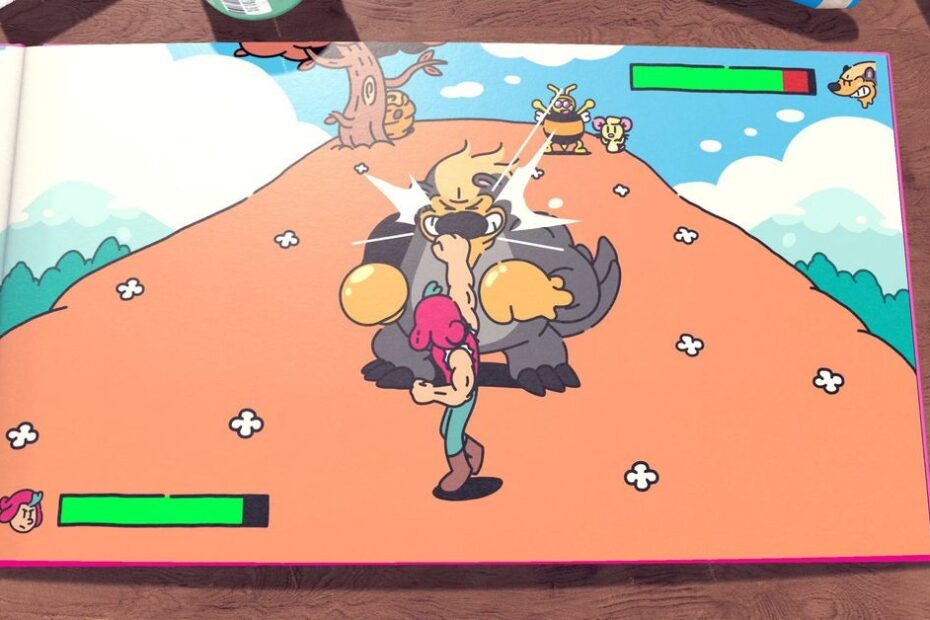The Plucky Squire is a game that leaps off the page — literally. It takes place in a storybook world rendered in an adorable two dimensions thanks to codirector and former Pokémon artist James Turner. But at certain points, the heroic lead character can venture into the real world and solve puzzles that mix 2D and 3D in inventive ways. Sometimes, you’re moving objects between dimensions; other times, you’re rearranging the words in a book to create new outcomes. It’s as cute as it is creative, and it follows Sony’s Astro Bot in what is turning out to be a very good year for family-friendly games.
The game puts you in the role of Jot, the titular plucky squire, who has the unusual ability to exist outside of the book he stars in. The two worlds are drastically different: inside the storybook is bright, colorful, and simple, while the real world is appropriately dark and realistic. They’re distinct, but through Jot, the worlds intersect as he sets about saving the book from an evil wizard. Solving puzzles involves flipping through pages to pull items from the past, using language to bypass barriers, and occasionally boxing a bear. It’s silly and heartfelt and, at times, calls to mind the 2D segments in Nintendo classics Super Mario Odyssey and The Legend of Zelda: A Link Between Worlds.
“The idea of contrast was really important to the game.”
For Turner, the initial idea for the game came during a lull, when he had just left Pokémon developer Game Freak but hadn’t yet started work at All Possible Futures, the studio he cofounded with Jonathan Biddle. “I left Game Freak, and then I had nothing to do,” he tells The Verge. “To fill that void, I started drawing a webcomic.” That comic, called Cosmic, included a number of characters and ideas that would eventually make their way into The Plucky Squire as its storybook narrative took shape.
For Turner — who frequently posts hilarious mashup illustrations and who designed notable pokémon like Polteageist — one of the goals of the game was to create a unique clash of styles. Not only should the dimensions in The Plucky Squire play different, but they should look different as well. It’s an idea that came about early in development; initially, when Jot jumped into the real world, he was cel-shaded to keep his cartoony style. Eventually, though, it became clear that a more realistic, almost toy-like version of the character worked better.
Image: All Possible Futures
“It reduced the realism of the outside world quite significantly in a strange way,” Turner says of the cel shading. “Even though the outside world was very real, if the object that you’re looking at 90 percent of the time [isn’t], it starts to affect how you see the rest of the world.” He adds that “the idea of contrast was really important to the game.”
A good example is early on in The Plucky Squire when Jot is in search of a bow-and-arrow to complete a quest. This involves jumping through a portal into the real world, navigating a very messy desk filled with obstacles, and then jumping into a card ripped out of Magic: The Gathering to battle an elf. When Jot finally reaches his destination, there are three distinct art styles onscreen: storybook 2D, realistic 3D, and detailed fantasy art. “I thought that clash of styles would be the most jaw-dropping,” Turner explains.
“There’s a big gap outside of Nintendo.”
Outside of its visuals, The Plucky Squire is also notable for being an experience that works really well for all ages. The action and puzzles have just enough depth to them to be satisfying while not being intimidating for younger or less experienced players. It’s like a streamlined Zelda adventure, with some nice quality-of-life features, like an optional hint system that doesn’t give too much away. It’s a style of game that can be hard to find outside of something from Nintendo (which includes the upcoming Echoes of Wisdom). But titles like Astro Bot and The Plucky Squire are showing it’s possible for other developers, as well.
“There are lots of people that want to play those games, and they haven’t been catered to as much as they possibly should have been,” says Turner. “It does feel like there’s a big gap outside of Nintendo where it would be nice if we had those games more regularly. There’s a need for them.”
The Plucky Squire is out now on the Nintendo Switch, PlayStation, Xbox, and PC.
